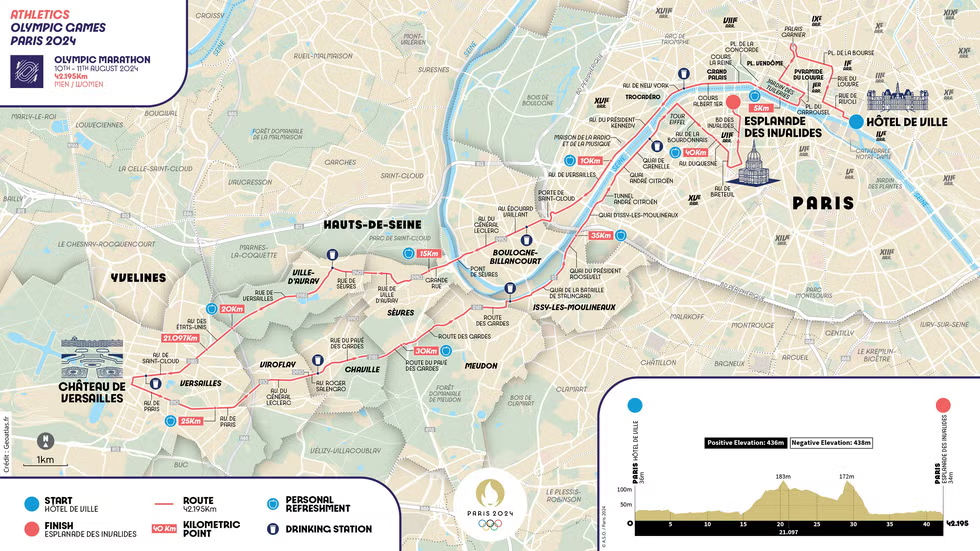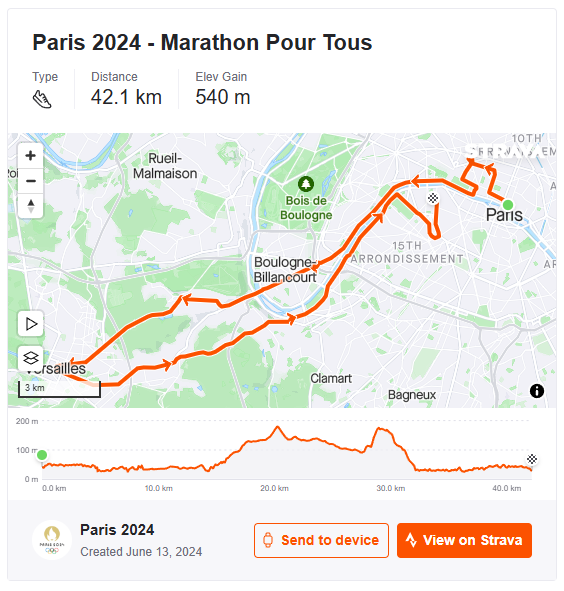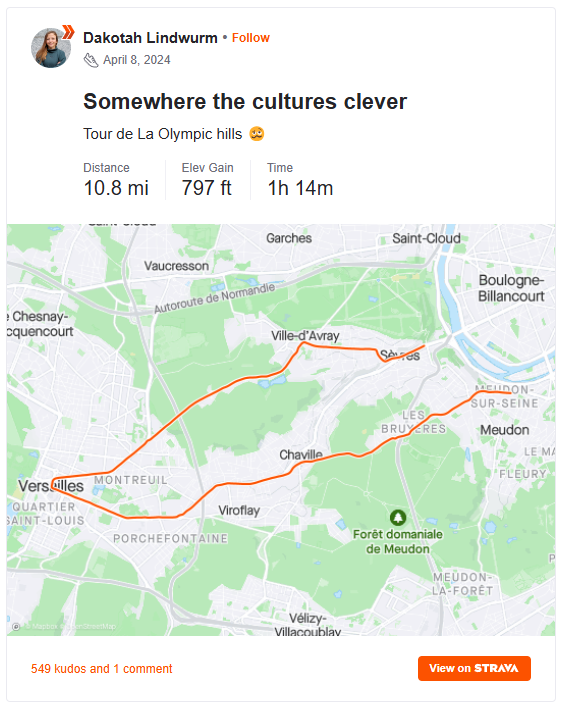It’s true: This may be the most grueling Olympic marathon route ever.
BY SARAH LORGE BUTLER, BRIAN DALEK AND BEN HOBSON
The final weekend of the 2024 Paris Olympics will host back-to-back days of thrilling marathons. These prestigious races, set against the backdrop of two of France’s most iconic landscapes—Paris and Versailles—will weave through a tapestry of history, culture, and breathtaking scenery. They begin on August 10 with the men’s race, and then, in a nod to the 40th anniversary of the first women’s Olympic Marathon in Los Angeles, the Paris Olympics will conclude on August 11 with the women’s race for the first time in history.
Here are some of the key details you’ll want to know.
What sites will the runners pass?
It’s not a bad way to tour the area, and it’s quite different than the Paris Marathon that is held each April. Athletes will find themselves tracing a route that dances through nine arrondissements (neighbourhoods) of Paris along the banks of the Seine. The runners will begin at the Hôtel de Ville, or city hall, and then pass landmarks such as the Palais Garnier opera house, Place Vendôme, the Louvre museum, and past the Trocadéro.
Next, they will leave the city to run through historic French towns, including Sevres, on their way to Versailles. The return to the city is a different route and will take them through the Forêt Domaniale de Meudon, a forest.

Hôtel de Ville will be where the runners begin the marathon.
When back in the city, they will be on the Left Bank and run past the Eiffel Tower as well as Parisian neighbourhoods. The race ends at the Esplanade des Invalides, in which Napoleon is buried.
This route is based on significant French history. In October 1789, between 6,000 and 7,000 Parisian women, joined by men, marched from the Hôtel de Ville through the city to Versailles. It was because of that march that Louis XVI agreed to ratify the Universal Declaration of the Rights of Man and Citizens. The marathoners are symbolically running in their footsteps.
How tough is the course?
Unlike some more recent Olympics, this course isn’t a circuit of repeated loops. Instead, it’s a full loop starting in Paris and loops down to Versailles outside of the city.
While the elevation profile for the first 14 kilometres looks fairly tame, once the runners are past the halfway mark the landscape changes. The most notable course feature is the three uphill stretches—they’re incredibly steep and very long.
The first big hill comes just before the 16 kilometre mark, and it climbs at a 4 percent grade, which is roughly the same as Boston’s famed Newton hills. The difference with the Paris version is that it ascends for about 2 kilometres before it levels off for a bit.
The next hill at the 19 kilometre mark is at 5 percent, steeper than anything on the Boston course and 900 metres long. But those two are just appetisers for the real challenge. That hits just after the 20 kilometre mark.
Runners will have to climb for 600 metres, at an average grade of 10.5 percent. Yes, picture putting your treadmill at 10 percent and trying to run up it at marathon pace.
Now it’s not quite this very hilly race in Lansdale, but as far as Olympic courses go, it’s going to be tough!
In total, the route will include 1,430 feet (436m) of elevation gain. Possibly more challenging is the 1,437 (438m) feet of descent. The make-or-break point for the route might be just after that final brutal uphill, when they are bombing downhill—at some points at a gradient of 13.5 percent. Runners will have to be efficient going down, without pounding so much they trash their quads before the final flat stretch before the finish.

To put the course into some more perspective, the World Marathon Majors that are considered the hilliest—Boston and New York City—each have an elevation gain of a little over 800 (244m) total feet.
This course will make the fastest marathoners in the world look almost human at times.
How do the marathoners feel about the course?
Pat Tiernan, an Olympian for Australia who is running the marathon, made two trips to Paris from his training base with Puma in North Carolina to examine the course. His first trip, in early April, was just to get a feel for the course. The second, in late May, was to train on it.
“The first thing you notice,” Tiernan said in a phone call with Runner’s World, “is that it’s going to be a brutal course. There are going to be people walking.”
If you look closely at the official Strava route, you can spot some U.S. Olympic marathoners on the leaderboards of the course’s toughest segments.

On April 10, U.S. team member Clayton Young did a 20 kilometre run on the hilliest section of the course, where he “pushed the uphills, chilled the downhills.” During the steepest climb—right before the mile 18 split—Young tackled a 0.77 kilometre segment in 3:09, giving him a modest average pace (for a world-class marathoner) of 4:20 per kilometre. But if you look at Strava’s “grade adjusted pace,” which factors in elevation, that 4:20 converts to 3:06 kilometre pace. His average heart rate was 179 beats per minute.

Dakotah Lindwurm, a U.S. team member for the women, also previewed the course in April in a run she called, “Tour de La Olympic hills 🥴].” She racked up an impressive 16 “course records” during her 17.5 kilometre workout, and on the same steep segment that Young ran, she averaged 4:48 pace with a grade-adjusted pace of 3:19 per kilometre.

Emily Sisson, the U.S. record holder in the marathon, has been training for both the hills and the flats. “We’ve been doing a lot of stuff on hills, because [we] want to come out of the hills into the last 10K feeling good,” she says. “That’s also why you don’t want to slack on 10K work, because it could be quite fast at the end. So kind of trying to do it all.”
Tiernan agreed with Sisson on the unique challenge. If marathoners go too hard through the hills, they could struggle at the end, he said. If they go too easy through the hills and subsequent descents, they might be out of touch by the final 10K. He said the Paris course is as “if you were to do a 10K road race, then go and run a hard 10K hill cross country course, then a 10K road race.”
If nothing else, it could make for some surprises on the podium.
When exactly are the races?
The men’s event happens on Saturday, August 10. The following day for the women’s race, the 2024 Paris Olympics fully conclude in honour of the 40th anniversary of the first women’s Olympic marathon event, won by Joan Benoit-Samuelson.
Who are the major names in each race?
Both races are packed with star power in the form of returning Olympic champions, world record holders, and World Marathon Majors winners. The biggest storyline in the men’s race is whether Eliud Kipchoge, the two-time Olympic marathon gold medalist who many consider to be the greatest of all time, will be able to retain his crown in what may be his final Olympics at age 39.
The women’s event is even more stacked and should make for quite the event to cap off the 2024 Olympics. Newly ratified world record holder Tigist Assefa of Ethiopia will have to match speed and strategy against the likes of Hellen Obiri and Peres Jepchirchir of Kenya and the Netherlands’s Sifan Hassan, who is running the marathon after racing in the 5,000 and 10,000 metres on the track.
Men’s Marathon Contenders
- Eliud Kipchoge, Kenya (2:01:09)
- Kenenisa Bekele, Ethiopia (2:01:41)
- Benson Kipruto, Kenya (2:02:16)
- Tamirat Tola, Ethiopia (2:03:39)
- Emile Cairess, UK (2:06:46)
Women’s Marathon Contenders
- Tigist Assefa, Ethiopia (2:11:53)
- Sifan Hassan, Netherlands (2:13:44)
- Peres Jepchirchir, Kenya (2:16:16)
- Emily Sisson, USA (2:18:29)
- Hellen Obiri, Kenya (2:21:38)
- Rose Chelimo, Bahrain (2:22:51)
- Fiona O’Keeffe, USA (2:22:10)
- Sharon Lokedi, Kenya (2:22:45)
Did you know there is a mass participation race?
If not, now you do. It’s called the Marathon Pour Tous, and we’re lucky enough to have someone from the team running it – Ali Ball. There will be a full marathon and a 10K on the same route as the Olympic marathon on the evening of August 10. Yes, a night race in the City of Lights. More than 20,000 participants are expected for each event.